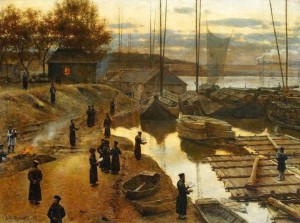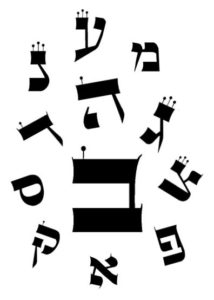On Rosh Hashanah, there is a widespread custom to go to a body of water and symbolically “shake off” one’s sins into the water. This little ritual is called Tashlich (more accurately, Tashlikh), a name that comes from Micah 7:19, where the prophet declares that God will “cast away”, tashlikh, all of the people’s sins into the depths of the sea. Where did this custom come from, and why are some people careful to avoid it?
A look through the sources reveals that no ancient text, mystical or otherwise, mentions Tashlich. It is not in the Zohar. It is not in the Shulchan Arukh either. It is discussed by the Rama, Rabbi Moshe Isserles (c. 1530-1572), who wrote the “tablecloth” to the Shulchan Arukh to incorporate Ashkenazi traditions. Tashlich did indeed originate as an Ashkenazi custom. The earliest source to mention it is the Maharil of Mainz (Rabbi Ya’akov Levi Moelin, c. 1365-1427). The Maharil explained that the reason for going to a body of water is to recall the famous Midrash about Abraham and Isaac on their way to the Akedah (which took place on Rosh Hashanah), when Satan drew up a large river before them to stop them from fulfilling God’s command. Undeterred, they went into the torrential waters anyway and continued on their journey.
The Rama adds more, and connects the practice with Creation itself. After all, Rosh Hashanah commemorates Creation, which began with the Spirit of God “hovering over the waters” (Genesis 1:2). He also notes the Micah verse above, and that we are metaphorically casting away our sins into the sea (but not literally casting them away, of course—one still needs to genuinely repent!) The Rama was a contemporary of the Arizal (Rabbi Itzchak Luria, 1534-1572), and the two probably passed away in the very same year. The Arizal’s father was Ashkenazi, but he was raised by his Sephardi mother and uncle in Egypt. As such, the Arizal conducted his life entirely according to Sephardic norms, prayers, and customs—except for the High Holidays, when he followed the Ashkenazi rite. The Arizal was therefore quite familiar with Ashkenazi High Holiday customs, and it was through him that Tashlich spread to the Sephardic and Mizrachi world as well.
Not surprisingly, the Arizal is the first kabbalist to have spoken about Tashlich. In Sha’ar HaKavanot on Rosh Hashanah, Rabbi Chaim Vital (who was Sephardi) records the Arizal’s teachings, and starts by reminding us “The meaning of the custom instituted by the Ashkenazim to go on the first day of Rosh Hashanah, after Minchah, a bit before sunset, to the sea or to a spring or to a well, which they call Tashlikh… and recite there three times the verses ‘Mi El kamocha…’” (Micah 7:18-20) The Arizal goes on to explain that the verses in Micah have 13 parts which parallel God’s 13 Attributes of Mercy, as follows:
מי אל כמוך א’. נושא עון ב’. ועובר על פשע ג’. לשארית נחלתו ד’. לא החזיק לעד אפו ה’. כי חפץ חסד הוא ו’. ישוב ירחמנו ז’. יכבוש עוונותינו ח’. ותשליך במצולות ים כל חטאתם ט’. תתן אמת ליעקב י’. חסד לאברהם י”א. אשר נשבעת לאבותינו י”ב. מימי קדם י”ג
The Arizal explains at length the deeper mystical meaning here, and how the 13 parallel the 13 parts of God’s “image” or “visage”, so to speak. (These correspond to the 13 “locks” of the beard, as explored in ‘Shaving and the Mystical Power of Beards’ in Garments of Light.)
The Arizal then explains that there is a powerful allusion in the words m’tzulot yam, “depths of the sea”. He points out that m’tzulot (מצלות) is an anagram of tzel mavet (צל מות), the “shadow of death” that King David mentions in Psalms. Last week, we saw how “Shadow of Death” is one of the seven realms of the underworld. The Arizal says that m’tzulot yam is another name for the Primordial Serpent and the forces of evil. The Arizal does not state that performing Tashlich will save one from these forces, rather it is the study of Torah that offers protection from m’tzulot yam. So, Tashlich is really only a symbolic ritual. For this reason, even many kabbalists avoided performing Tashlich.
The most famous of these kabbalists is the Vilna Gaon, who was one of the great expositors of the Arizal’s Kabbalah. Nonetheless, and despite being Ashkenazi himself, the Vilna Gaon did not perform Tashlich (see Ma’aseh Rav #209). Others cautioned against Tashlich for halakhic reasons, since it is forbidden to feed wild animals on Shabbat or Yom Tov, and those that empty out their pockets into the water may inadvertently provide crumbs for fish. (Some people intentionally throw bread crumbs into the water, which is definitely forbidden, and the Maharil himself mentions this.) Although the custom spread by way of the Arizal to the Sephardi world, there are still numerous Sephardi and Mizrachi communities that do not do Tashlich either. Those that do should only symbolically shake the corners of their clothes or tzitzit. Truly, even this is not necessary, as the Arizal did not mention it, and only describes the prayers and mystical meditations to have while by a body of water.
A final note on the connection between Tashlich and tzitzit. On a mystical level, tzitzit connects to the great “electric” mystical force known as chashmal (חשמל), which can be split into ח׳ שמל, a garment with a fringe of eight strings (this was explored in depth in ‘The Secret Power of Tzitzit’ in Garments of Light, Volume Two). Wearing tzitzit serves as a sort of “force field” against the forces of evil. Such a garment also protects from m’tzulot yam, especially if the tzitzit are dyed blue with tekhelet, as the Torah intends. Our Sages state that the blue is for the colour of the sea, which reflects the sky, which is symbolic of God’s blue sapphire throne. Hidden away within the Throne is the Or haGanuz, the divine light of Creation which, as mentioned in multiple sources (such as in Yalkut Shimoni here, for instance), is destined to destroy all the forces of evil in the time to come.
Shana Tova u’Metuka!


